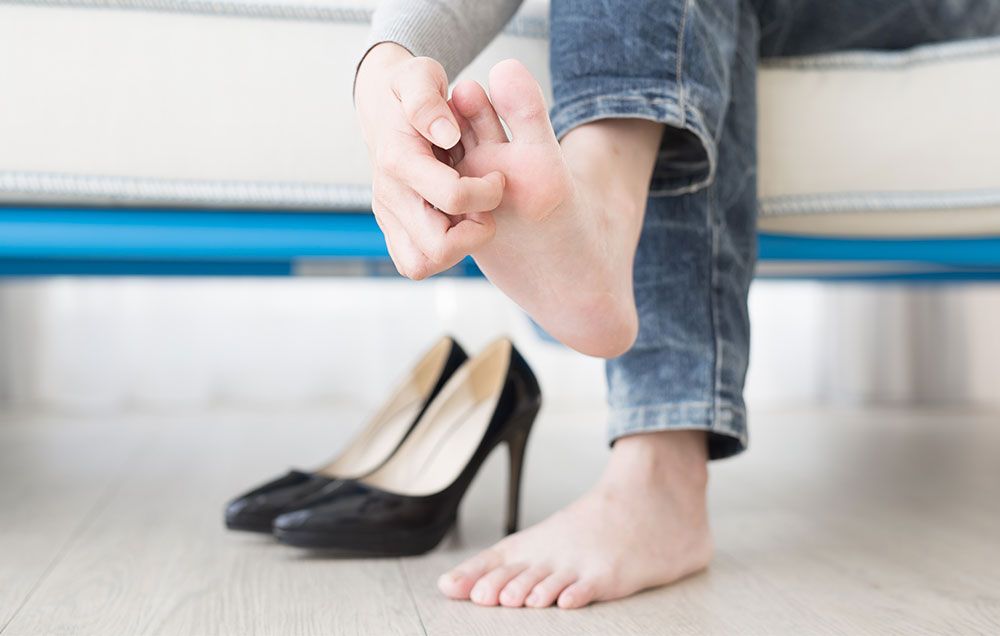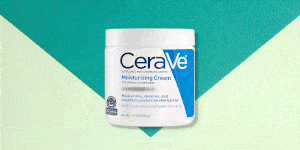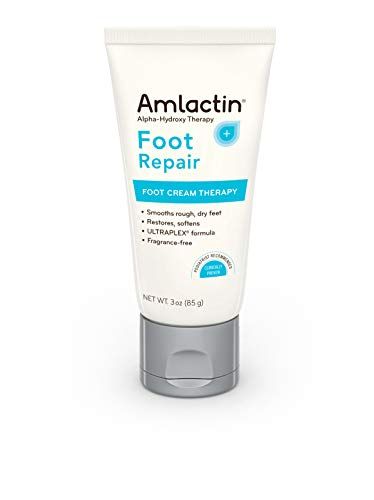Popcorn’s popped, Friends is cued up, and it’s officially time to get comfy, so you kick your feet up onto the coffee table and—whaaat is that? Are your feet…peeling? (Hey, at least your pedi looks great.)
“Peeling feet is definitely common, and there are various reasons why,” says Rebecca Pruthi, DPM, a podiatrist and owner of Foot Care of Manhattan. “We’re on our feet all the time and the constant pounding and walking can cause cracking and scaling of the skin,” she says.
Not to mention the seasons can also play a role in roughing up your feet, with summer typically leading to peeling and blistering and winter to dryness, cracked heels, and, (again) peeling. So when your dogs start barking over the scaly skin situation going on down there, it can be super tempting to take matters into your own hands by, say, picking. Don’t, per Jennifer Tauber, DPM, a podiatrist in New Canaan, Connecticut.
“The biggest mistake that people make is trying to remove the peeling skin on their own, either by using some type of instrument, which can lead to bleeding and infection, or an over the counter remedy that may be too harsh for the skin and cause more irritation than good.”
Instead, Tauber recommends scheduling an appointment with your doc, especially if it’s your first time having any unexplained peeling since it “can happen for different reasons.” And the same is true if you start to experience any signs of infection, such as redness, drainage, itchiness, or pain, she adds.
Now, back to those flaky feetsies you have propped up in front of you: what’s going on? Well, peeling feet can be about more than just pounding the pavement or braving the elements. So, here are seven reasons why your feet might be peeling:
1. Fungal infections
According to Pruthi, the most common reason patients have peeling feet is a fungal infection (like athlete’s foot)—although they might not always realize it. “A lot of times it just presents itself as peeling skin and patients don’t have the itchiness, so they don’t know it’s a fungal infection,” Pruthi says. So if your skin starts mysteriously peeling all of a sudden, get it checked out sooner rather than later. Once you have a fungal infection on your skin, it can easily infect your toenail, which Pruthi warns can be very difficult to get rid of.
“What I find that happens is that the skin infects the nails, the nails re-infect the skin, back and forth, back and forth,” she says. “So whatever presents itself first, you want to knock it away.”
How to treat: If it’s a minor fungal infection like athlete’s foot, then an OTC anti-fungal spray or cream might get the job done, according to Tauber. If not and/or you’re dealing with a more severe situation, then you might need a prescription-strength cream. Either way, if you have a fungal infection on your feet then it’s likely in your shoes too, Tauber says. So, be sure to keep your kicks dry and hit them with an anti-fungal spray as well.
2. Sweaty exercise routines
Excess perspiration and moist environments often cause these foot infections, which lead to peeling. That might mean that your gym regimen, especially if there’s some hot yoga thrown in, can contribute to your peeling feet. Pruthi warns that “anything you’re doing barefoot, or if you’re sharing mats, or if you’re doing hot yoga in a moist environment” can lead to this bacterial or fungal infection. See a doc if you think you have it.

How to treat: Douse your sneaks with a deodorizing shoe spray (or even Lysol) to kill fungi and bacteria, says Hillary Brenner, DPM, a podiatrist in New York City.She also recommends wearing cotton socks to wick sweat away, using orthotics such as those with a soft top cover that absorbs moisture, and, if possible, investing in a second pair of workout shoes to rotate between the two.
3. Strappy heels
Many women, including Pruthi, love to wear strappy shoes in the summer. But as anyone who hasn’t properly broken in her new heels knows, snug footwear can cause some serious friction. “Anything that causes friction can cause blisters, which can also result in scaling or peeling of the skin,” Pruthi says. “Don’t wear shoes for too long, wear natural materials that kind of mold to your feet, and as soon as you start to feel friction, change your shoes. Don’t allow too much of that to dig into your skin.” And you shouldn’t only focus on the impact of your heels. Flip flops are also a culprit of foot discomfort and peeling.
How to treat: “You can apply moleskin or blister patches—both of which are sold at drugstores—to the areas where you think you may have rubbing or irritation,” Tauber explains. At the end of the day, however, your best bet is stop wearing those shoes all together and, if possible, go for a pair made of natural materials (read: no plastic).
4. Sunburns
Nobody goes to the beach with the intentions of getting a beet-red, painful-to-touch sunburn. But while you might be good at remembering to lather sunscreen onto your face, back, and shoulders, Pruthi notices that “the feet always get the short end of the stick.” So when you just dip your feet in the ocean and assume your lotion has stayed on… maybe reapply. Sunburns lead to peeling and other scary things. Don’t let your feet be on the receiving end of dangerous UV rays unprotected!
How to treat: Like with any other sunburn, you’re going to want to apply aloe gel to the affected areas once a day as well as a hydrating cream like coco butter or even coconut oil twice a day, Brenner says. Also a good idea? Soaking in a combo of Epsom salts and warm water.
Watch a hot doc explain peeling feet:
5. Eczema
“Eczema is a skin condition that manifests through scaling of the skin,” says Pruthi. It can cause peeling, itching, and dryness all over the body—including the soles of your feet. Although many have experienced eczema since childhood, people can also develop the skin condition as an adult. Luckily there are many topical remedies available through podiatrists and dermatologists.

How to treat: Check out your nearby pharmacy for medicated or eczema-specific creams to use twice a day. Still experiencing peeling? Then Tauber recommends recommends consulting a doc who might prescribe an Rx-strength cream and/or instruct you to start using a foot soak for 20 minutes a few times each week to help moisturize the affected skin even more. And if your feet are super itchy, a little cortisone cream can help, Brenner says. You only want to use this as needed, however, because “it can weaken the skin,” she explains.
6. Dehydration
Dehydration can make you tired, decrease your metabolism, contribute to break outs, and… that’s right, cause your feet to peel, too! “If you’re not hydrated enough, your skin starts to flake off everywhere on our bodies,” Pruthi says. Remember: Water is your friend. (Just try not to go overboard.)

How to treat: One more time for the folks in the back: water is key. So much so that it’s the first line of treatment that both Brenner and Tauber recommend for scaly skin in this case. Moisturizing your feet with fragrance free creams, such as Amlactin and Cerave per Tauber, on the reg can also help. “Also, if you have very rough and callused feet a lotion or cream with glycolic acid or urea is beneficial for those tough spots,” she adds.
7. Just because
Although there can be some eyebrow-raising reasons why your feet are peeling, it’s not always a bad thing. “Naturally your body wants to slough off skin,” Pruthi says. “So I always tell patients to get a pumice stone and just kind of in the shower rub your feet and get dead skin cells off so that it regenerates new skin.” So show your feet a little love—and they’ll love you right back.
How to treat: “Use a good foot moisturizer daily and on occasion, a pumice stone to sough off the dead skin,” Tauber says.
Source: Read Full Article
